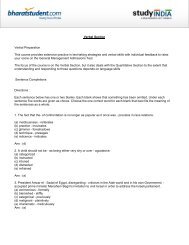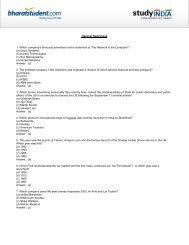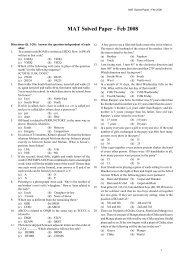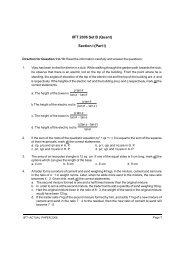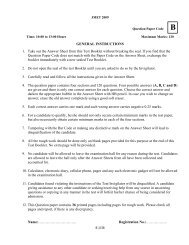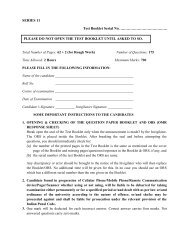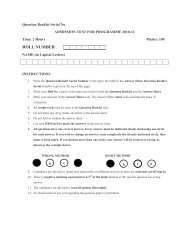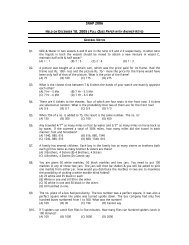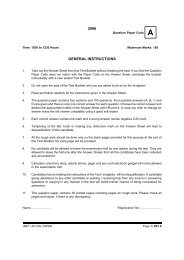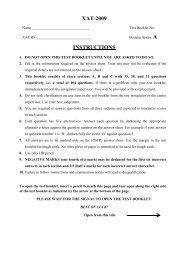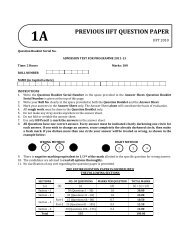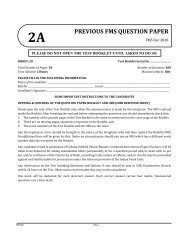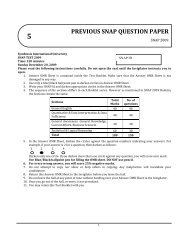Create successful ePaper yourself
Turn your PDF publications into a flip-book with our unique Google optimized e-Paper software.
Q.15 (A) The school is opposite to the township building<br />
(B) In chapter 1, she accepts her first job as a kitchen maid, but by chapter 3, she is cooking for<br />
an Indian prince<br />
(C) Hold the rifle firmly against your shoulder, and then you should take careful aim<br />
(D) I like an occasional cup of coffee, for they give me an added lift<br />
Solution:<br />
15. The answer is option (B). Option (A) is ruled out because of the wrong usage of the<br />
preposition ‘to’. Option (C) is incorrect as the comma and the conjunction ‘and ‘are used<br />
together. In option (D), the personal pronoun ‘they’ should be replaced by ‘it’ (third person<br />
singular pronoun) as it refers to ‘cup of coffee’.<br />
Directions: In Question 16, identify the option <strong>with</strong> CORRECT punctuation.<br />
Q.16 (A) The people of this company, have, always been aware of the need, for product’s of<br />
better quality and lower prices.<br />
(B) The new residents of Canada faced still more hardships; loneliness, life in a wilderness, even<br />
death.<br />
(C) In April 1789 the ship left Ceylon <strong>with</strong> its cargo.<br />
(D) A fairy story as distinct, from a merry tale or an animal story, is a serious tale <strong>with</strong> a human<br />
hero and a happy ending.<br />
Solution:<br />
16. The answer option (D). Option (A) is incorrect because there are unnecessary punctuations<br />
throughout the sentence. Option (B) has an unnecessary semicolon after ‘hardships’- either a<br />
colon or a comma can be used there. In option (C), a comma is missing after the year ‘1789’.<br />
Directions: Questions 17 and 18 relate to the passage given below.<br />
With each passing day, it is getting easier to believe that the acceleration in India’s economic<br />
growth from around 6% to 8% is here to stay. The hard part is trying to explain why this has<br />
happened. How this is explained is important since it has a bearing on our future policy.<br />
As per conventional wisdom, India’s growth accelerated to around 6% in the nineties from the<br />
historical rate of 3.5% because ‘reforms’ had unleashed the pent-up energies of India<br />
entrepreneurs long shackled by the socialist raj. It slowed subsequently because ‘reforms’ had<br />
lost momentum. The last three years’ spurt in growth is the fortuitous result of a global economic<br />
boom. Once the world economy slows down, we will he back to 6% growth–unless we proceed<br />
<strong>with</strong> ‘second generation’ reforms.<br />
However, each of these propositions bristles <strong>with</strong> problems. It is not true that economic growth<br />
rate accelerated to 6% in the nineties. In fact, research has shown that the ‘structural break’ in<br />
India’s economic growth occurred not in the early nineties but in the eighties, when economic<br />
growth accelerated to close to 6%. The growth in the first decade after reforms was not<br />
significantly different from the growth rate in the eighties. The ‘reforms’ in the sense of marketoriented<br />
or even pro-business policies did not commence overnight in 1991, but had commenced



